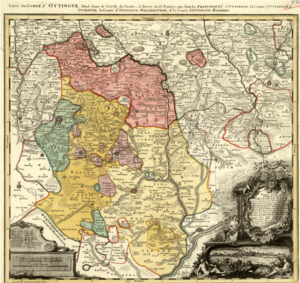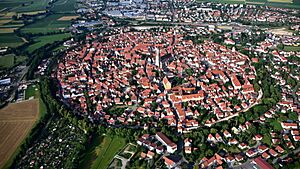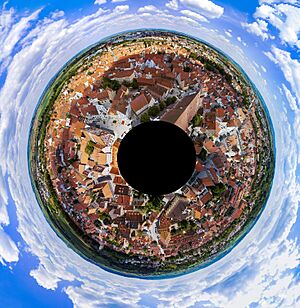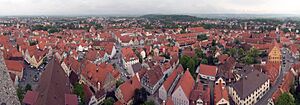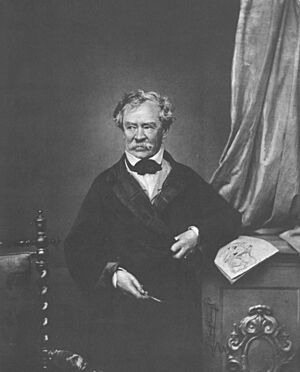Nördlingen facts for kids
Quick facts for kids
Nördlingen
|
||
|---|---|---|

Nördlingen, south view from the church tower Daniel
|
||
|
||
| Country | Germany | |
| State | Bavaria | |
| Admin. region | Swabia | |
| District | Donau-Ries | |
| Elevation | 441 m (1,447 ft) | |
| Population
(2022-12-31)
|
||
| • Total | 21,009 | |
| Time zone | CET/CEST (UTC+1/+2) | |
| Postal codes |
86720
|
|
| Dialling codes | 09081 | |
| Vehicle registration | DON, NÖ | |
| Website | www.noerdlingen.de | |
Nördlingen is a town in Germany, located in the region of Swabia, Bavaria. About 20,674 people live there. It's special because it was built inside a giant crater! This crater, called the Nördlinger Ries, was formed 15 million years ago by a huge meteorite. The meteorite hit the Earth at an amazing speed of 70,000 kilometers per hour!
Nördlingen was first mentioned in history in the year 898. It was the site of two important battles during the Thirty Years' War (1618-1648). Today, Nördlingen is one of the few towns in Germany that still has its old city walls completely intact. Other towns with intact walls include Rothenburg ob der Tauber and Dinkelsbühl.
One of the town's most famous sights is the 90-meter-tall steeple of Saint George's Church, known as "Daniel". This steeple is made from a special rock called suevite, which contains tiny diamonds! Other interesting buildings include the town hall, built in the 13th century, and the Spital, which used to be a medieval hospital. You can also visit the Rieskrater Museum, which teaches you all about the meteorite crater.
Nördlingen has several other museums too. There's the Bavarian Railway Museum, the Nördlingen city museum (Stadtmuseum), and the city wall museum (Stadtmauermuseum). The Augenblick museum is also fun, with old panoramas, magic lanterns, silent films, and musical instruments like barrel organs and gramophones.
The town is also known for the Scharlachrennen, which means "Scarlet Race". This is a horse race tournament that started way back in 1463. Today, it includes different horse sports like eventing, jumping, and dressage.
Contents
History of Nördlingen
Early Times and Celts
Evidence found in the Ofnet Caves near Nördlingen shows that people lived here a very long time ago, in the late Stone Age. In 1908, an archaeologist found two pits in the Large Ofnet cave. These pits contained human skulls, arranged in a circle and covered with red paint. These skulls are about 9,000 years old!
Many other ancient sites have been found around Nördlingen. These include settlements from the Stone Age, Bronze Age, and the Celtic Iron Age.
Roman Times
The area where Nördlingen is now was once part of the Roman Empire. Not much research has been done on the Roman period in the town itself. However, a Roman villa (a large country house) has been found and excavated in the Holheim area, and you can visit it today.
Another Roman villa and a burial ground were found in the Baldingen area. A Roman settlement was built here around 85 C.E. It lasted until 259–260 C.E., when it was destroyed by Alemanni tribes from Germany. The Roman settlement might have been called Septemiacum, but its exact name is still a bit of a mystery.
The Middle Ages
The Alemanni people lived in the Nördlingen area during the 6th and 7th centuries. During this time, the region slowly became Christian. The name "Nordilinga" first appeared in official documents in 898. This is why the town celebrates this year as its "foundation" date. Nördlingen grew into an important market town under the rule of the Bishops of Regensburg.
In 1215, Emperor Frederick II gave Nördlingen "city rights," making it an important imperial city of the Holy Roman Empire. That same year, the first city wall was built. You can still see where this wall stood today. In 1219, the "Nördlingen Pentecost fair" was first mentioned. This fair is still a popular festival in the city today!
Nördlingen became a very important trading center. This was because it was located where two major trade routes crossed. People traded grain, animals, textiles, furs, and metal goods there. It was one of the most important long-distance trade fairs in the region, along with Frankfurt am Main.
In 1238, a big fire destroyed much of Nördlingen, but the city quickly rebuilt itself. Later, many craftsmen, especially leather workers and weavers, settled outside the city walls. In 1327, the circular wall that you can see today was built. This wall made the walled part of the city four times bigger! Construction on St. George's Church began in 1427.
Early Modern Period
In 1529, Nördlingen supported the Protestant Reformation, a big religious movement. By 1555, the Reformation was fully established in the city.
Sadly, between 1589 and 1598, some people in Nördlingen were wrongly accused of witchcraft. During this time, 34 women and one man were executed.
It's sometimes said that a short version of William Shakespeare's Romeo and Juliet was performed in Nördlingen in 1604. This would have been one of the first times a Shakespeare play was performed outside England. However, the actors were actually denied permission to perform by the local leaders, but they were paid for their efforts.
Nördlingen was the site of two major battles during the Thirty Years' War. In the first Battle of Nördlingen in 1634, the Swedish Protestant army was defeated by the imperial army. The city had to open its gates and pay a lot of money, but it wasn't destroyed. However, many people in the city died from hunger and sickness during and after the siege.
Things got even worse after the second Battle of Nördlingen in 1645. It took until 1939 for Nördlingen to have as many people as it did before the war in 1618. In the early 1700s, during the War of the Spanish Succession, nearby battles also affected the city. These wars caused trade to move to seaports, and Nördlingen lost its importance as a trading center. Because of this economic slowdown, Nördlingen's old medieval buildings and streets stayed very well preserved.
In 1803, Nördlingen lost its special status as an imperial city and became part of Bavaria. In 1806, Bavaria became a kingdom and left the Holy Roman Empire.
Modern Times
On May 15, 1849, Nördlingen got its first railway connection. This connected it to Nuremberg. A third railway line opened in 1863, connecting it to Aalen.
During World War II, Nördlingen experienced air raids in the spring of 1945. The train station and some houses were destroyed, and St. George's Church was damaged. However, most of the historic part of the city was saved. After the war, Nördlingen was part of the American occupation zone. A camp was set up in the city for people who had been forced from their homes, mostly from Latvia and Lithuania. More than 4,500 people settled permanently in Nördlingen after the war.
Jewish families have lived in Nördlingen since the Middle Ages. They had a cemetery and a synagogue built in 1885. Sadly, the synagogue was destroyed by the Nazis in November 1938. A plaque now marks the spot where it stood. In 1979, a memorial stone was placed in the Jewish cemetery to remember Jewish victims of the Holocaust.
In 1972, Nördlingen became part of a new district called Donau-Ries.
Economy
Some important companies in Nördlingen are:
- C.H. Beck – a book publisher
- Varta – a company that makes batteries
- Maierbier – a brewery
Nördlingen also has a train station that connects it to other cities.
Sport
The local sports club, the TSV 1861 Nördlingen, has very successful basketball teams for both men and women. The club's football (soccer) team is also very strong in the region. One of its most famous former players is Gerd Müller, a legendary football player who was born and grew up in Nördlingen. The team's stadium was renamed in his honor in 2008.
Impact Diamonds
Did you know that the stone buildings in Nördlingen contain millions of tiny diamonds? These diamonds are all smaller than 0.2 millimeters across. When the meteorite hit 15 million years ago, it created the Nördlinger Ries crater. This impact also created an estimated 72,000 tons of these tiny diamonds! This happened because the meteorite hit a local graphite deposit (a type of carbon). Later, stone from this area was used to build many of the town's buildings.
Twin towns – sister cities
Nördlingen is connected with these cities around the world:
Notable people
Many interesting people have come from Nördlingen, including:
- Friedrich Herlin (1425/1430–1500), a painter
- Bartholomäus Zeitblom (c. 1455 – c. 1518), a painter
- Albrecht Adam (1786–1862), a war artist
- Heinrich Adam (1787–1862), a painter
- Johann Michael Voltz (1784–1858), a graphic artist and painter
- Friedrich Voltz (1817–1886), a painter
- Robert Beyschlag (1838-1903), a painter
- Gerd Müller (1945-2021), a famous football player and coach
- Anton Meyer (born 1955), an economist and professor
- Sabine Haubitz (born 1959), an art photographer
- Michael Lutz (born 1982), a footballer
- Frank Kechele (born 1986), a racing driver
- Stefan Rieß (born 1988), a footballer
- Steffen Lang (born 1993), a footballer
See also
 In Spanish: Nördlingen para niños
In Spanish: Nördlingen para niños



